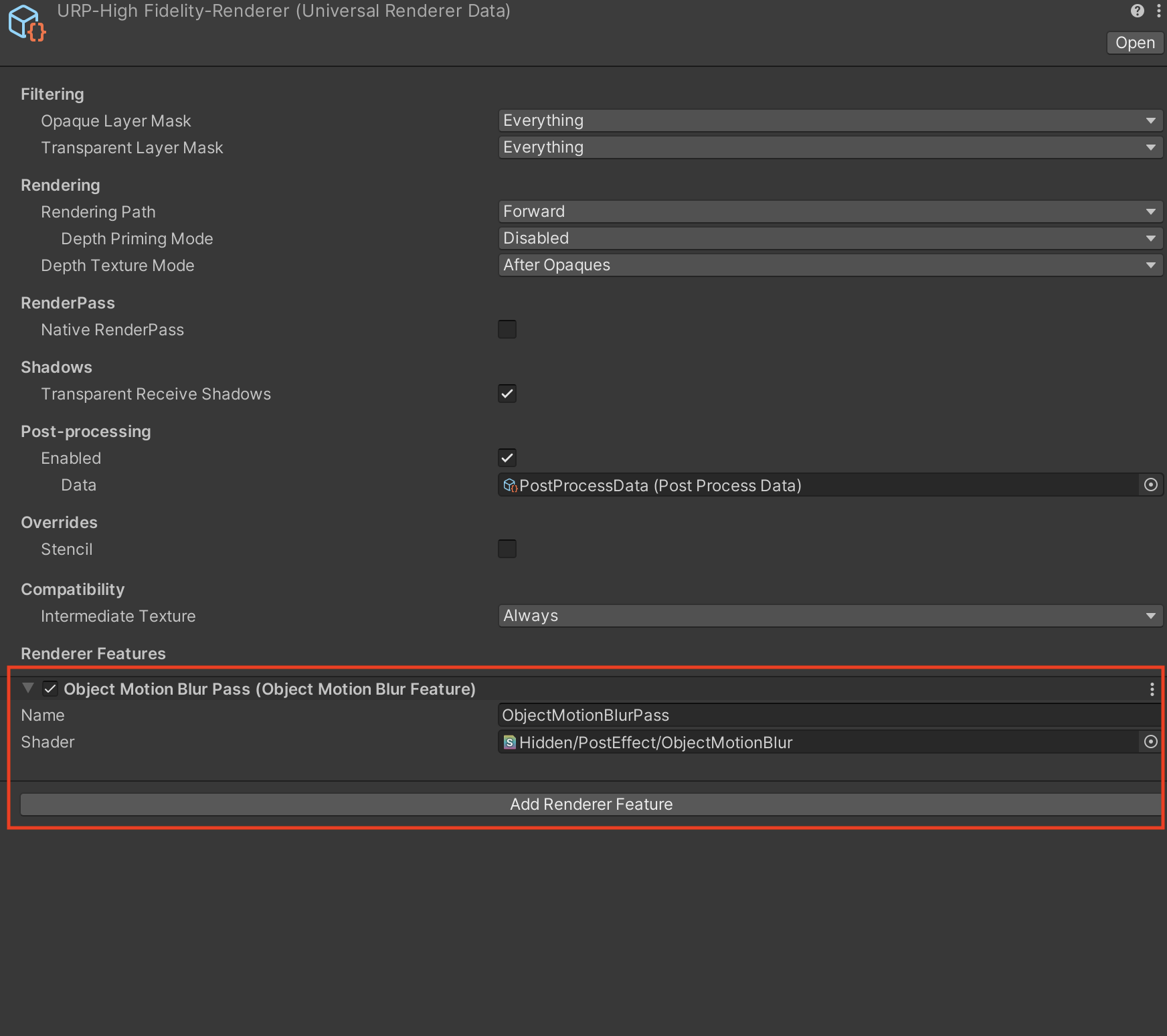本記事はQualiArts Advent Calendar 2022 10日目の記事です。
オブジェクトモーションブラーとは?
オブジェクトモーションブラーとはその名前の通り、高速に変化するオブジェクトに対してかかるブラーです。
| オブジェクトモーションブラーOFF | オブジェクトモーションブラーON |
|---|---|
 |
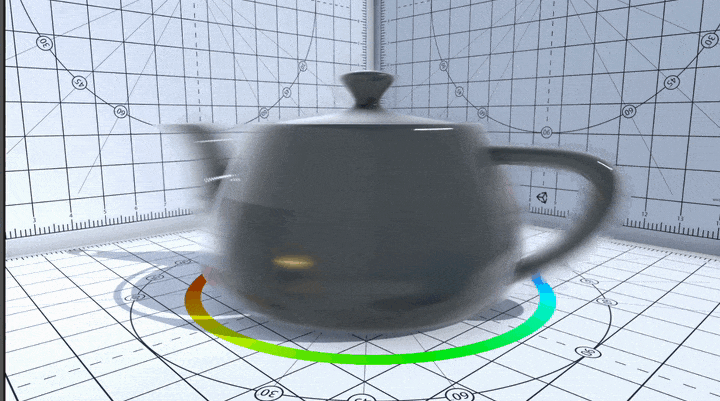 |
URPに搭載されているカメラモーションブラー
URPにはMotionBlurのVolumeが存在します。
しかしこれはカメラモーションブラーといい、カメラの移動によってかかるブラーのため、上記のような高速で回転するオブジェクトにはブラーがかかりません。

| URPのモーションブラーOFF | URPのモーションブラーON |
|---|---|
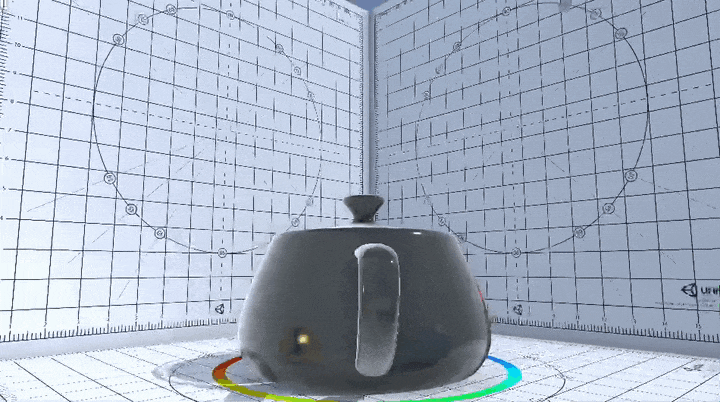 |
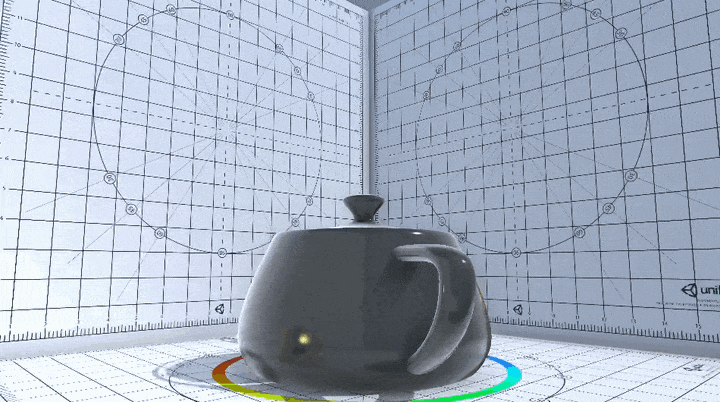 |
PostProcessingStack V2に搭載されているオブジェクトモーションブラー
一方でPostProcessingStack V2(以下PostProcessing)にはオブジェクトモーションブラーが実装されています。
そこで今回はPostProcessingに搭載されているオブジェクトモーションブラーをURPに移植することでURPでオブジェクトモーションブラーを使えるようにします。
配布プロジェクト
本解説で作成したプロジェクトはこちらで公開しています。
解説
本記事ではURPのRenderFeatureやVolumeの仕組みをある程度理解している方を対象にしています。
またオブジェクトモーションブラーの動作原理については、私自身が十分に理解しておらず、詳細な情報を伝えることができませんが、興味がある方はA Fast and Stable Feature-Aware Motion Blur Filterの論文をお読みください。
環境
- Unity2021.3.13f1
- Universal Render Pipeline 12.1.7
処理を移植する
VolumeComponentの移植
まずオブジェクトモーションブラーパラメーターをURPで実装します。
PostProcessingではここで実装さています。
これによりオブジェクトモーションブラーのパラメーターをVolumeComponentから設定できるようになります。
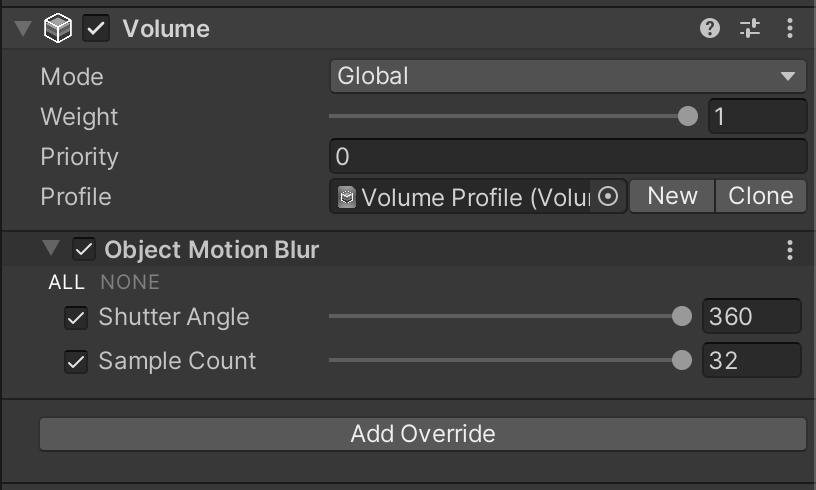
using UnityEngine.Rendering;
[System.Serializable, VolumeComponentMenu("Custom/Object Motion Blur")]
public class ObjectMotionBlur : VolumeComponent
{
public ClampedFloatParameter shutterAngle = new ClampedFloatParameter(0, 0, 360);
public ClampedIntParameter sampleCount = new ClampedIntParameter(8, 4, 32);
public bool IsActive()
{
return active && shutterAngle.overrideState && shutterAngle.value > 0 && sampleCount.value > 0;
}
}
シェーダーの移植
次にオブジェクトモーションブラーを実現するシェーダーをPostProcessingから移植します。
PostProcessingではここで実装されている処理になります。
移植後のシェーダー
Shader "Hidden/PostEffect/ObjectMotionBlur"
{
HLSLINCLUDE
#pragma target 3.0
#include "Packages/com.unity.render-pipelines.universal/Shaders/PostProcessing/Common.hlsl"
#include "Packages/com.unity.render-pipelines.universal/ShaderLibrary/Core.hlsl"
// SourceTexture
TEXTURE2D(_SourceTex); float4 _SourceTex_TexelSize;
// Camera depth texture
TEXTURE2D_X_FLOAT(_CameraDepthTexture); SAMPLER(sampler_CameraDepthTexture);
// Camera motion vectors texture
TEXTURE2D(_MotionVectorTexture); SAMPLER(sampler_MotionVectorTexture);
float4 _MotionVectorTexture_TexelSize;
// Packed velocity texture (2/10/10/10)
TEXTURE2D(_VelocityTex); SAMPLER(sampler_VelocityTex);
float2 _VelocityTex_TexelSize;
// NeighborMax texture
TEXTURE2D(_NeighborMaxTex); SAMPLER(sampler_NeighborMaxTex);
float2 _NeighborMaxTex_TexelSize;
// Velocity scale factor
float _VelocityScale;
// TileMax filter parameters
int _TileMaxLoop;
float2 _TileMaxOffs;
// Maximum blur radius (in pixels)
half _MaxBlurRadius;
float _RcpMaxBlurRadius;
// Filter parameters/coefficients
half _LoopCount;
// struct VaryingsDefault
// {
// float4 vertex : SV_POSITION;
// float2 texcoord : TEXCOORD0;
// float2 texcoordStereo : TEXCOORD1;
// };
// -----------------------------------------------------------------------------
// Prefilter
float Linear01DepthPPV2(float z)
{
float isOrtho = unity_OrthoParams.w;
float isPers = 1.0 - unity_OrthoParams.w;
z *= _ZBufferParams.x;
return (1.0 - isOrtho * z) / (isPers * z + _ZBufferParams.y);
}
// Velocity texture setup
half4 FragVelocitySetup(Varyings i) : SV_Target
{
// Sample the motion vector.
float2 v = SAMPLE_TEXTURE2D(_MotionVectorTexture, sampler_MotionVectorTexture, i.uv).rg;
// Apply the exposure time and convert to the pixel space.
v *= (_VelocityScale * 0.5) * _MotionVectorTexture_TexelSize.zw;
// Clamp the vector with the maximum blur radius.
v /= max(1.0, length(v) * _RcpMaxBlurRadius);
// Sample the depth of the pixel.
half d = Linear01Depth(SAMPLE_DEPTH_TEXTURE(_CameraDepthTexture, sampler_CameraDepthTexture, i.uv),_ZBufferParams);
// Pack into 10/10/10/2 format.
return half4((v * _RcpMaxBlurRadius + 1.0) * 0.5, d, 0.0);
}
half2 MaxV(half2 v1, half2 v2)
{
return dot(v1, v1) < dot(v2, v2) ? v2 : v1;
}
// TileMax filter (2 pixel width with normalization)
half4 FragTileMax1(Varyings i) : SV_Target
{
float4 d = _SourceTex_TexelSize.xyxy * float4(-0.5, -0.5, 0.5, 0.5);
half2 v1 = SAMPLE_TEXTURE2D(_SourceTex, sampler_LinearClamp, i.uv + d.xy).rg;
half2 v2 = SAMPLE_TEXTURE2D(_SourceTex, sampler_LinearClamp, i.uv + d.zy).rg;
half2 v3 = SAMPLE_TEXTURE2D(_SourceTex, sampler_LinearClamp, i.uv + d.xw).rg;
half2 v4 = SAMPLE_TEXTURE2D(_SourceTex, sampler_LinearClamp, i.uv + d.zw).rg;
v1 = (v1 * 2.0 - 1.0) * _MaxBlurRadius;
v2 = (v2 * 2.0 - 1.0) * _MaxBlurRadius;
v3 = (v3 * 2.0 - 1.0) * _MaxBlurRadius;
v4 = (v4 * 2.0 - 1.0) * _MaxBlurRadius;
return half4(MaxV(MaxV(MaxV(v1, v2), v3), v4), 0.0, 0.0);
}
// TileMax filter (2 pixel width)
half4 FragTileMax2(Varyings i) : SV_Target
{
float4 d = _SourceTex_TexelSize.xyxy * float4(-0.5, -0.5, 0.5, 0.5);
half2 v1 = SAMPLE_TEXTURE2D(_SourceTex, sampler_LinearClamp, i.uv + d.xy).rg;
half2 v2 = SAMPLE_TEXTURE2D(_SourceTex, sampler_LinearClamp, i.uv + d.zy).rg;
half2 v3 = SAMPLE_TEXTURE2D(_SourceTex, sampler_LinearClamp, i.uv + d.xw).rg;
half2 v4 = SAMPLE_TEXTURE2D(_SourceTex, sampler_LinearClamp, i.uv + d.zw).rg;
return half4(MaxV(MaxV(MaxV(v1, v2), v3), v4), 0.0, 0.0);
}
// TileMax filter (variable width)
half4 FragTileMaxV(Varyings i) : SV_Target
{
float2 uv0 = i.uv + _SourceTex_TexelSize.xy * _TileMaxOffs.xy;
float2 du = float2(_SourceTex_TexelSize.x, 0.0);
float2 dv = float2(0.0, _SourceTex_TexelSize.y);
half2 vo = 0.0;
UNITY_LOOP
for (int ix = 0; ix < _TileMaxLoop; ix++)
{
UNITY_LOOP
for (int iy = 0; iy < _TileMaxLoop; iy++)
{
float2 uv = uv0 + du * ix + dv * iy;
vo = MaxV(vo, SAMPLE_TEXTURE2D(_SourceTex, sampler_LinearClamp, uv).rg);
}
}
return half4(vo, 0.0, 0.0);
}
// NeighborMax filter
half4 FragNeighborMax(Varyings i) : SV_Target
{
const half cw = 1.01; // Center weight tweak
float4 d = _SourceTex_TexelSize.xyxy * float4(1.0, 1.0, -1.0, 0.0);
half2 v1 = SAMPLE_TEXTURE2D(_SourceTex, sampler_LinearClamp, i.uv - d.xy).rg;
half2 v2 = SAMPLE_TEXTURE2D(_SourceTex, sampler_LinearClamp, i.uv - d.wy).rg;
half2 v3 = SAMPLE_TEXTURE2D(_SourceTex, sampler_LinearClamp, i.uv - d.zy).rg;
half2 v4 = SAMPLE_TEXTURE2D(_SourceTex, sampler_LinearClamp, i.uv - d.xw).rg;
half2 v5 = SAMPLE_TEXTURE2D(_SourceTex, sampler_LinearClamp, i.uv).rg * cw;
half2 v6 = SAMPLE_TEXTURE2D(_SourceTex, sampler_LinearClamp, i.uv + d.xw).rg;
half2 v7 = SAMPLE_TEXTURE2D(_SourceTex, sampler_LinearClamp, i.uv + d.zy).rg;
half2 v8 = SAMPLE_TEXTURE2D(_SourceTex, sampler_LinearClamp, i.uv + d.wy).rg;
half2 v9 = SAMPLE_TEXTURE2D(_SourceTex, sampler_LinearClamp, i.uv + d.xy).rg;
half2 va = MaxV(v1, MaxV(v2, v3));
half2 vb = MaxV(v4, MaxV(v5, v6));
half2 vc = MaxV(v7, MaxV(v8, v9));
return half4(MaxV(va, MaxV(vb, vc)) * (1.0 / cw), 0.0, 0.0);
}
// -----------------------------------------------------------------------------
// Reconstruction
// Interleaved gradient function from Jimenez 2014
// http://www.iryoku.com/next-generation-post-processing-in-call-of-duty-advanced-warfare
float GradientNoise(float2 uv)
{
uv = floor(uv * _ScreenParams.xy);
float f = dot(float2(0.06711056, 0.00583715), uv);
return frac(52.9829189 * frac(f));
}
// Returns true or false with a given interval.
bool Interval(half phase, half interval)
{
return frac(phase / interval) > 0.499;
}
// Jitter function for tile lookup
float2 JitterTile(float2 uv)
{
float rx, ry;
sincos(GradientNoise(uv + float2(2.0, 0.0)) * TWO_PI, ry, rx);
return float2(rx, ry) * _NeighborMaxTex_TexelSize.xy * 0.25;
}
// Velocity sampling function
half3 SampleVelocity(float2 uv)
{
half3 v = SAMPLE_TEXTURE2D_LOD(_VelocityTex, sampler_VelocityTex, uv, 0.0).xyz;
return half3((v.xy * 2.0 - 1.0) * _MaxBlurRadius, v.z);
}
// Reconstruction filter
half4 FragReconstruction(Varyings i) : SV_Target
{
// Color sample at the center point
const float4 c_p = SAMPLE_TEXTURE2D(_SourceTex, sampler_LinearClamp, i.uv);
// Velocity/Depth sample at the center point
const float3 vd_p = SampleVelocity(i.uv);
const float l_v_p = max(length(vd_p.xy), 0.5);
const float rcp_d_p = 1.0 / vd_p.z;
// NeighborMax vector sample at the center point
const float2 v_max = SAMPLE_TEXTURE2D(_NeighborMaxTex, sampler_NeighborMaxTex, i.uv + JitterTile(i.uv)).xy;
const float l_v_max = length(v_max);
const float rcp_l_v_max = 1.0 / l_v_max;
// Escape early if the NeighborMax vector is small enough.
if (l_v_max < 2.0) return c_p;
// Use V_p as a secondary sampling direction except when it's too small
// compared to V_max. This vector is rescaled to be the length of V_max.
const half2 v_alt = (l_v_p * 2.0 > l_v_max) ? vd_p.xy * (l_v_max / l_v_p) : v_max;
// Determine the sample count.
const half sc = floor(min(_LoopCount, l_v_max * 0.5));
// Loop variables (starts from the outermost sample)
const half dt = 1.0 / sc;
const half t_offs = (GradientNoise(i.uv) - 0.5) * dt;
float t = 1.0 - dt * 0.5;
float count = 0.0;
// Background velocity
// This is used for tracking the maximum velocity in the background layer.
float l_v_bg = max(l_v_p, 1.0);
// Color accumlation
float4 acc = 0.0;
UNITY_LOOP
while (t > dt * 0.25)
{
// Sampling direction (switched per every two samples)
const float2 v_s = Interval(count, 4.0) ? v_alt : v_max;
// Sample position (inverted per every sample)
const float t_s = (Interval(count, 2.0) ? -t : t) + t_offs;
// Distance to the sample position
const float l_t = l_v_max * abs(t_s);
// UVs for the sample position
const float2 uv0 = i.uv + v_s * t_s * _SourceTex_TexelSize.xy;
const float2 uv1 = i.uv + v_s * t_s * _VelocityTex_TexelSize.xy;
// Color sample
const float3 c = SAMPLE_TEXTURE2D_LOD(_SourceTex, sampler_LinearClamp, uv0, 0.0).rgb;
// Velocity/Depth sample
const float3 vd = SampleVelocity(uv1);
// Background/Foreground separation
const float fg = saturate((vd_p.z - vd.z) * 20.0 * rcp_d_p);
// Length of the velocity vector
const float l_v = lerp(l_v_bg, length(vd.xy), fg);
// Sample weight
// (Distance test) * (Spreading out by motion) * (Triangular window)
const float w = saturate(l_v - l_t) / l_v * (1.2 - t);
// Color accumulation
acc += half4(c, 1.0) * w;
// Update the background velocity.
l_v_bg = max(l_v_bg, l_v);
// Advance to the next sample.
t = Interval(count, 2.0) ? t - dt : t;
count += 1.0;
}
// Add the center sample.
acc += float4(c_p.rgb, 1.0) * (1.2 / (l_v_bg * sc * 2.0));
//return half4(0,0,1,1);
return half4(acc.rgb / acc.a, c_p.a);
}
ENDHLSL
SubShader
{
Cull Off ZWrite Off ZTest Always
// (0) Velocity texture setup
Pass
{
HLSLPROGRAM
#pragma vertex Vert
#pragma fragment FragVelocitySetup
ENDHLSL
}
// (1) TileMax filter (2 pixel width with normalization)
Pass
{
HLSLPROGRAM
#pragma vertex Vert
#pragma fragment FragTileMax1
ENDHLSL
}
// (2) TileMax filter (2 pixel width)
Pass
{
HLSLPROGRAM
#pragma vertex Vert
#pragma fragment FragTileMax2
ENDHLSL
}
// (3) TileMax filter (variable width)
Pass
{
HLSLPROGRAM
#pragma vertex Vert
#pragma fragment FragTileMaxV
ENDHLSL
}
// (4) NeighborMax filter
Pass
{
HLSLPROGRAM
#pragma vertex Vert
#pragma fragment FragNeighborMax
ENDHLSL
}
// (5) Reconstruction filter
Pass
{
HLSLPROGRAM
#pragma vertex Vert
#pragma fragment FragReconstruction
ENDHLSL
}
}
}
パスの移植
次にCPU側の処理を移植します。
このコードは上記のシェーダーで定義したパスの呼び出しやパラメーターを制御します。
これは後述するScriptableRenderPassを継承したクラスのExecuteメソッド中に入れる事もできますが、今回はわかりやすくするためにPostProcessingMotionBlurというクラスに分離しました。
PostProcessingではここで実装されている処理です。
コード全文
using UnityEngine;
using UnityEngine.Rendering;
public class PostProcessingMotionBlur
{
enum Pass
{
VelocitySetup,
TileMax1,
TileMax2,
TileMaxV,
NeighborMax,
Reconstruction
}
class ShaderIDs
{
internal static readonly int VelocityScale = Shader.PropertyToID("_VelocityScale");
internal static readonly int MaxBlurRadius = Shader.PropertyToID("_MaxBlurRadius");
internal static readonly int RcpMaxBlurRadius = Shader.PropertyToID("_RcpMaxBlurRadius");
internal static readonly int VelocityTex = Shader.PropertyToID("_VelocityTex");
internal static readonly int Tile2RT = Shader.PropertyToID("_Tile2RT");
internal static readonly int Tile4RT = Shader.PropertyToID("_Tile4RT");
internal static readonly int Tile8RT = Shader.PropertyToID("_Tile8RT");
internal static readonly int TileMaxOffs = Shader.PropertyToID("_TileMaxOffs");
internal static readonly int TileMaxLoop = Shader.PropertyToID("_TileMaxLoop");
internal static readonly int TileVRT = Shader.PropertyToID("_TileVRT");
internal static readonly int NeighborMaxTex = Shader.PropertyToID("_NeighborMaxTex");
internal static readonly int LoopCount = Shader.PropertyToID("_LoopCount");
}
private void CreateTemporaryRT(CommandBuffer cmd, RenderTextureDescriptor rtDesc, int nameID, int width,
int height,
RenderTextureFormat rtFormat)
{
rtDesc.width = width;
rtDesc.height = height;
rtDesc.colorFormat = rtFormat;
cmd.GetTemporaryRT(nameID, rtDesc, FilterMode.Point);
}
public void ObjectMotionBlur(
CommandBuffer cmd,
Material material,
RenderTargetIdentifier source,
RenderTargetIdentifier destination,
RenderTextureDescriptor desc)
{
var objectMotionBlur = VolumeManager.instance.stack.GetComponent<ObjectMotionBlur>();
const float kMaxBlurRadius = 5f;
var vectorRTFormat = RenderTextureFormat.RGHalf;
var packedRTFormat = SystemInfo.SupportsRenderTextureFormat(RenderTextureFormat.ARGB2101010)
? RenderTextureFormat.ARGB2101010
: RenderTextureFormat.ARGB32;
// var desc = GetCompatibleDescriptor();
var width = desc.width;
var height = desc.height;
desc.colorFormat = packedRTFormat;
// Calculate the maximum blur radius in pixels.
// int maxBlurPixels = (int)(kMaxBlurRadius * context.height / 100);
int maxBlurPixels = (int)(kMaxBlurRadius * height / 100);
// Calculate the TileMax size.
// It should be a multiple of 8 and larger than maxBlur.
int tileSize = ((maxBlurPixels - 1) / 8 + 1) * 8;
// Pass 1 - Velocity/depth packing
var velocityScale = objectMotionBlur.shutterAngle.value / 360f;
material.SetFloat(ShaderIDs.VelocityScale, velocityScale);
material.SetFloat(ShaderIDs.MaxBlurRadius, maxBlurPixels);
material.SetFloat(ShaderIDs.RcpMaxBlurRadius, 1f / maxBlurPixels);
int vbuffer = ShaderIDs.VelocityTex;
CreateTemporaryRT(cmd, desc, vbuffer, width, height, packedRTFormat);
// cmd.Blit(BuiltinRenderTextureType.None, vbuffer, material, (int)Pass.VelocitySetup);
Blit(cmd, BuiltinRenderTextureType.None, vbuffer, material, (int)Pass.VelocitySetup);
// Pass 2 - First TileMax filter (1/2 downsize)
int tile2 = ShaderIDs.Tile2RT;
CreateTemporaryRT(cmd, desc, tile2, width / 2, height / 2, vectorRTFormat);
Blit(cmd, vbuffer, tile2, material, (int)Pass.TileMax1);
// Pass 3 - Second TileMax filter (1/2 downsize)
int tile4 = ShaderIDs.Tile4RT;
CreateTemporaryRT(cmd, desc, tile4, width / 4, height / 4, vectorRTFormat);
Blit(cmd, tile2, tile4, material, (int)Pass.TileMax2);
cmd.ReleaseTemporaryRT(tile2);
// Pass 4 - Third TileMax filter (1/2 downsize)
int tile8 = ShaderIDs.Tile8RT;
CreateTemporaryRT(cmd, desc, tile8, width / 8, height / 8, vectorRTFormat);
Blit(cmd, tile4, tile8, material, (int)Pass.TileMax2);
cmd.ReleaseTemporaryRT(tile4);
// Pass 5 - Fourth TileMax filter (reduce to tileSize)
var tileMaxOffs = Vector2.one * (tileSize / 8f - 1f) * -0.5f;
material.SetVector(ShaderIDs.TileMaxOffs, tileMaxOffs);
material.SetFloat(ShaderIDs.TileMaxLoop, (int)(tileSize / 8f));
int tile = ShaderIDs.TileVRT;
CreateTemporaryRT(cmd, desc, tile, width / tileSize, height / tileSize, vectorRTFormat);
Blit(cmd, tile8, tile, material, (int)Pass.TileMaxV);
cmd.ReleaseTemporaryRT(tile8);
// Pass 6 - NeighborMax filter
int neighborMax = ShaderIDs.NeighborMaxTex;
CreateTemporaryRT(cmd, desc, neighborMax, width / tileSize, height / tileSize, vectorRTFormat);
Blit(cmd, tile, neighborMax, material, (int)Pass.NeighborMax);
cmd.ReleaseTemporaryRT(tile);
// Pass 7 - Reconstruction pass
material.SetFloat(ShaderIDs.LoopCount, Mathf.Clamp(objectMotionBlur.sampleCount.value / 2, 1, 64));
Blit(cmd, source, destination, material, (int)Pass.Reconstruction);
cmd.ReleaseTemporaryRT(vbuffer);
cmd.ReleaseTemporaryRT(neighborMax);
}
private void Blit(CommandBuffer cmd, RenderTargetIdentifier source, RenderTargetIdentifier destination,
Material material, int passIndex = 0)
{
cmd.SetGlobalTexture(Shader.PropertyToID("_SourceTex"), source);
cmd.Blit(source, destination, material, passIndex);
}
}
ScriptableRenderPassを継承したPassの実装
ScriptableRenderPassを継承したパスを実装します。
オブジェクトモーションブラーを実現するためには、モーションベクターが必要になるためConfigureInput(ScriptableRenderPassInput.Motion)を指定して、URP側にモーションベクターパスの描画を要求します。
using UnityEngine;
using UnityEngine.Rendering;
using UnityEngine.Rendering.Universal;
public class ObjectMotionBlurPass : ScriptableRenderPass
{
private readonly ProfilingSampler _objectMotionBlurSampler = new("Object Motion Blur");
private readonly PostProcessingMotionBlur _postProcessingMotionBlur;
private readonly RenderTargetHandle _tmpColorBuffer;
private Material _material;
public ObjectMotionBlurPass(Shader shader)
{
// MotionVector要求する
ConfigureInput(ScriptableRenderPassInput.Motion);
_postProcessingMotionBlur = new PostProcessingMotionBlur();
_tmpColorBuffer.Init("_TempColorBuffer");
_material = CoreUtils.CreateEngineMaterial(shader);
}
public override void Execute(ScriptableRenderContext context, ref RenderingData renderingData)
{
ref var cameraData = ref renderingData.cameraData;
// SceneViewではブラーをかけない
if(cameraData.cameraType == CameraType.SceneView) return;
CommandBuffer cmd = CommandBufferPool.Get();
using (new ProfilingScope(cmd, _objectMotionBlurSampler))
{
var descriptor = cameraData.cameraTargetDescriptor;
var colorTarget = cameraData.renderer.cameraColorTarget;
// カメラの画像を_TempColorBufferにコピーする
cmd.GetTemporaryRT(_tmpColorBuffer.id, descriptor);
Blit(cmd, colorTarget, _tmpColorBuffer.id);
// オブジェクトモーションブラー
_postProcessingMotionBlur.ObjectMotionBlur(cmd, _material, _tmpColorBuffer.id, colorTarget, descriptor);
cmd.ReleaseTemporaryRT(_tmpColorBuffer.id);
}
context.ExecuteCommandBuffer(cmd);
CommandBufferPool.Release(cmd);
}
}
RenderFeatureの設定
最後にRendererにRenderFeatureを設定し、作成したシェーダーを割り当てたら完成です。
Shuntter Angleを変えることでブラーのかかり具合、Sample Countを変える事でブラーの精度(処理負荷)を制御できます。

